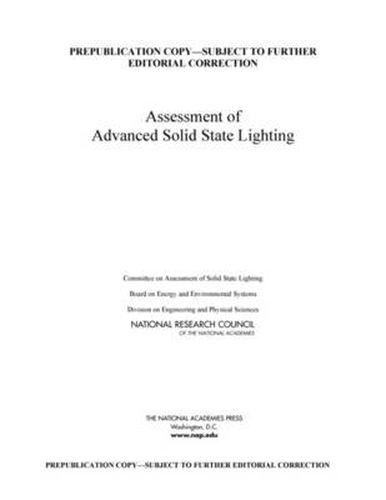Readings Newsletter
Become a Readings Member to make your shopping experience even easier.
Sign in or sign up for free!
You’re not far away from qualifying for FREE standard shipping within Australia
You’ve qualified for FREE standard shipping within Australia
The cart is loading…






The standard incandescent light bulb, which still works mainly as Thomas Edison invented it, converts more than 90% of the consumed electricity into heat. Given the availability of newer lighting technologies that convert a greater percentage of electricity into useful light, there is potential to decrease the amount of energy used for lighting in both commercial and residential applications. Although technologies such as compact fluorescent lamps (CFLs) have emerged in the past few decades and will help achieve the goal of increased energy efficiency, solid-state lighting (SSL) stands to play a large role in dramatically decreasing U.S. energy consumption for lighting. This report summarizes the current status of SSL technologies and products-light-emitting diodes (LEDs) and organic LEDs (OLEDs)-and evaluates barriers to their improved cost and performance.
Assessment of Advanced Solid State Lighting also discusses factors involved in achieving widespread deployment and consumer acceptance of SSL products. These factors include the perceived quality of light emitted by SSL devices, ease of use and the useful lifetime of these devices, issues of initial high cost, and possible benefits of reduced energy consumption.
$9.00 standard shipping within Australia
FREE standard shipping within Australia for orders over $100.00
Express & International shipping calculated at checkout
The standard incandescent light bulb, which still works mainly as Thomas Edison invented it, converts more than 90% of the consumed electricity into heat. Given the availability of newer lighting technologies that convert a greater percentage of electricity into useful light, there is potential to decrease the amount of energy used for lighting in both commercial and residential applications. Although technologies such as compact fluorescent lamps (CFLs) have emerged in the past few decades and will help achieve the goal of increased energy efficiency, solid-state lighting (SSL) stands to play a large role in dramatically decreasing U.S. energy consumption for lighting. This report summarizes the current status of SSL technologies and products-light-emitting diodes (LEDs) and organic LEDs (OLEDs)-and evaluates barriers to their improved cost and performance.
Assessment of Advanced Solid State Lighting also discusses factors involved in achieving widespread deployment and consumer acceptance of SSL products. These factors include the perceived quality of light emitted by SSL devices, ease of use and the useful lifetime of these devices, issues of initial high cost, and possible benefits of reduced energy consumption.